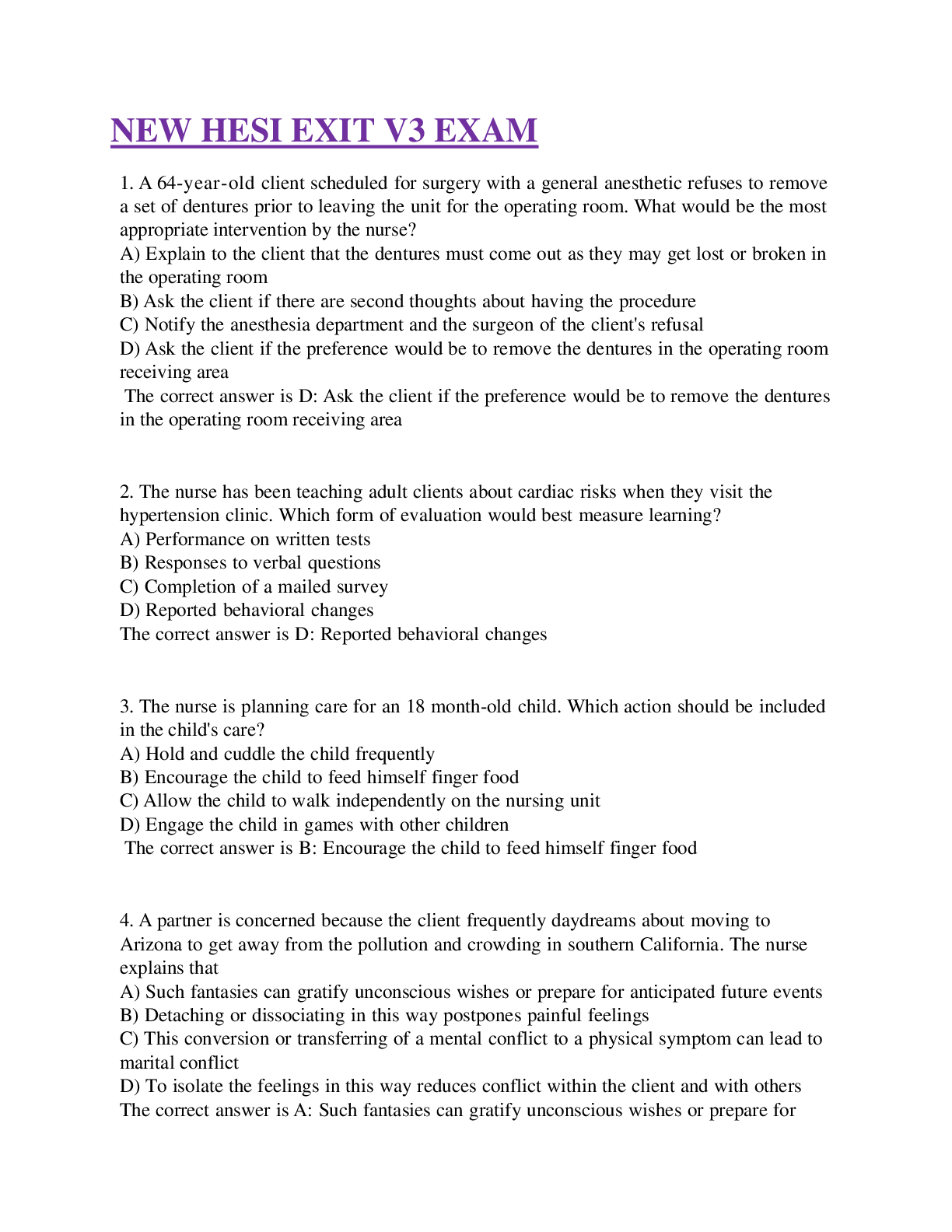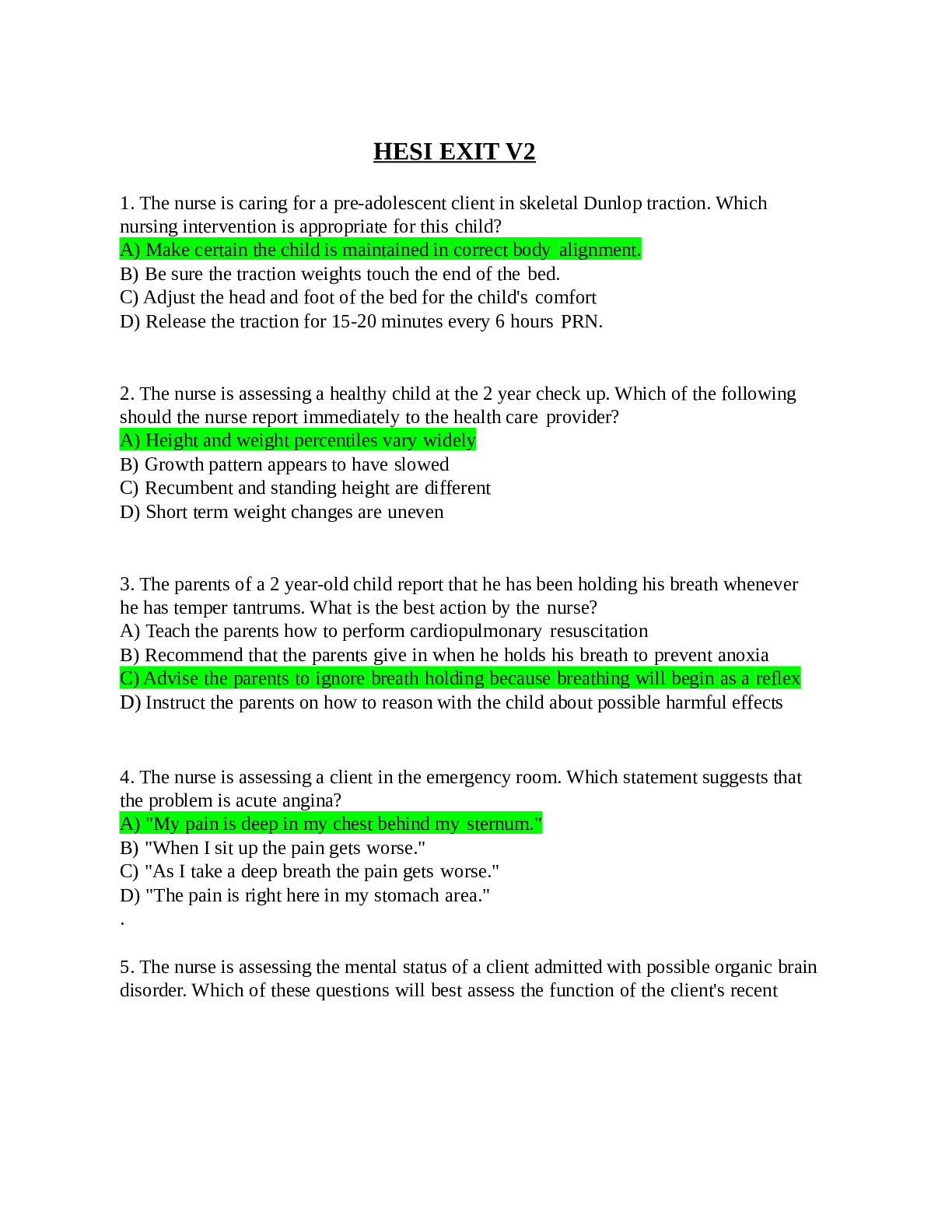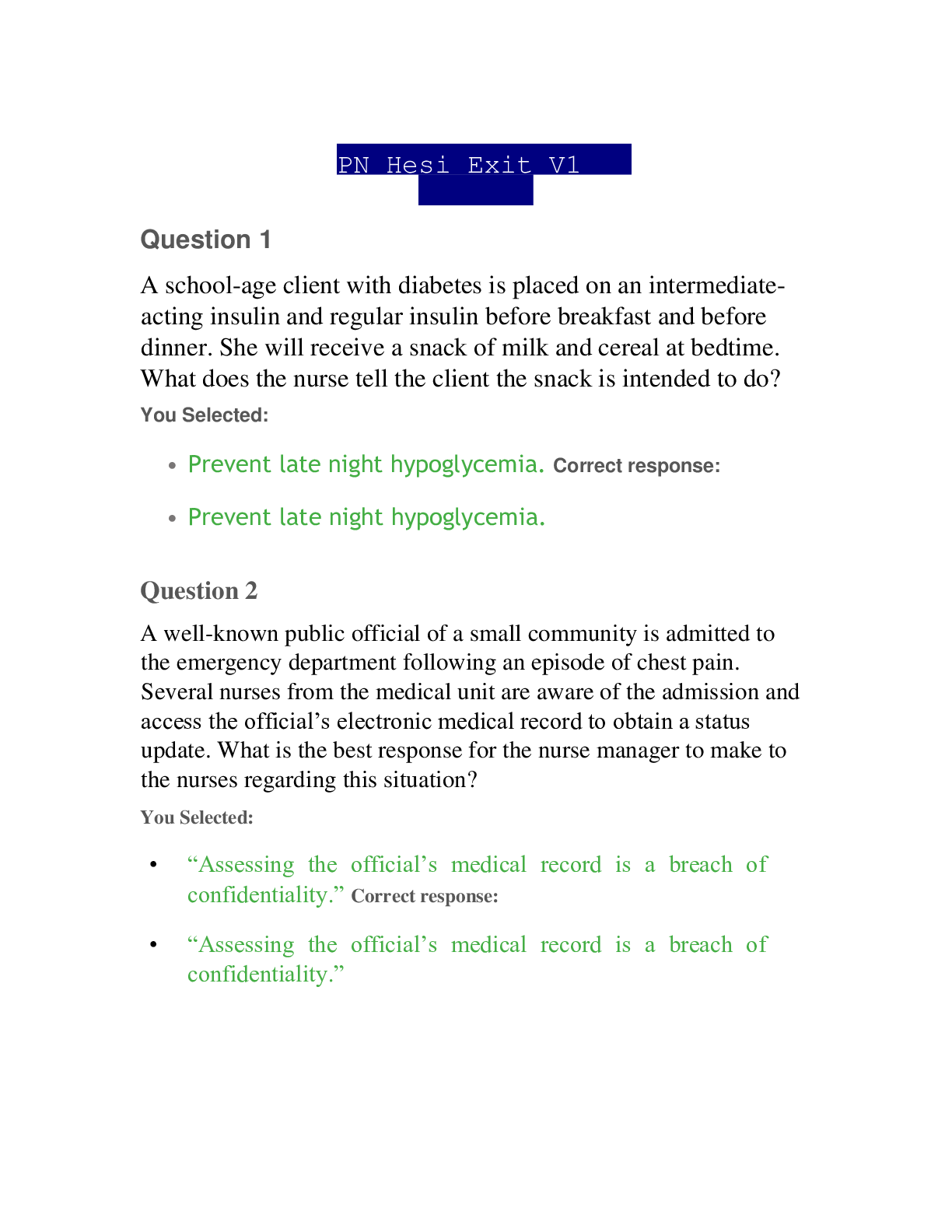HESI EXIT RN 2023 V3 160 Questions and answers
Document Content and Description Below
1. A male client with stomach cancer returns to the unit following a total gastrectomy. He has a nasogastric tube to suction and is receiving Lactated Ringer’s solution at 75 mL/hour IV. One hour ... after admission to the unit, the nurse notes 300 mL of blood in the suction canister, the client’s heart rate is 155 beats/minute, and his blood pressure is 78/48 mmHg. In addition to reporting the finding to the surgeon. Which action should the nurse implement first? a. Measure and document the client’s urinary output. b. Request the client’s reserved unit if packed red blood cells. c. Prepare the placement of a central venous catheter. d. Increase the infusion rate of Lactated Ringer’s solution. 2. an adult male who fell 20 feet from the roof of this home has multiple injuries, including a right pneumothorax. Chest tubes were inserted in the emergency department prior to his transfer to the intensive care unit (ICU). the nurse notes that the suction control chamber is bubbling at the - 10 cm H2O mark, with fluctuation in the water seal, and over the past hour 75 ml of bright red blood is measured in the collection chamber. Which intervention should the nurse implement? a. Add sterile water to the suction control chamber. b. Give blood from the collection chamber as autotransfusion c. Manipulate blood in tubing to drain into chamber. d. Increase wall suction to eliminate fluctuation in water seal. 3. A client who received hemodialysis yesterday is experiencing a blood pressure of 200/100 mmHg, heart rate 110 beats/minute, and respiratory rate 36 breaths/minute. The client is manifesting shortness of breath, bilateral 2+ pedal edema, and an oxygen saturation on room air of 89%. Which action should the nurse take first? a. Elevate the foot of the bed. b. Restrict the client’s fluid. c. Begin supplemental oxygen. d. Prepare the client for hemodialysis. 4. A client with Addison’s crisis is admitted for treatment with adrenal cortical supplementation. Based on the client’s admitting diagnosis, which findings require immediate action by the nurse? (Select all that apply) a. Headache and tremors b. Irregular heart rate c. Skin hyperpigmentation d. Postural hypotension e. Pallor and diaphoresis 5. An older client is admitted with fluid volume deficit and dehydration. Which assessment finding is the best indicator of hydration that the nurse should report to the healthcare provider? a. Urine specific gravity is 1.040 b. Systolic blood pressure decreases 10 points when standing. c. The client denies being thirsty. d. Skin tenting occurs when the client’s forearm is pinched. 6. After an inservice about electronic health record (EHR) security and safeguarding client information, the nurse observes a colleague going home with printed copies of client information in a uniform pocket. Which action should the nurse take? a. File a detailed incident report with the specific hiring facility. b. Warn the colleague that their actions are unprofessional. c. Comment anonymously about the action of a staff discussion board. d. Communicate the colleague’s actions to the unit charge nurse. 7. The nurse is evaluating a tertiary prevention program for clients with cardiovascular disease implemented in a rural health clinic. Which outcome indicate the program is effective? a. At-risk clients received an increased number of routine health screenings. b. Clients reported having new confidence in making healthy food choices. c. Clients who incurred disease complications promptly received rehabilitation. d. Client relapse rate of 30% in a 5-year community-wide anti-smoking campaign. 8. The nurse is caring for a client with chronic obstructive pulmonary disease (COPD) who uses oxygen at 2 L/minute per nasal cannula continuously. The nurse observes that the client is having increased shortness of breath with respirations at 23 breaths/minute. Which action should the nurse implement first? a. Determine if the client is experiencing any anxiety. b. Auscultate the client’s bilateral lung sounds and oxygen saturation. c. Notify the healthcare provider about the client’s distress. d. Assess the delivery mechanism of the oxygen tank, tubing, and cannula. 9. Which statement by a client who is 24 hours post-subtotal thyroidectomy requires an immediate investigation by the nurse? a. “When I get out of bed quickly, I feel a little dizzy.” b. “The dressing over my incision feels like it is too tight.” c. “I’m most comfortable when the head of the bed is raised.” d. “This IV infusion makes me urinate more often than usual.” 10. An older adult male who is in his early 70’s is admitted to the emergency department because of a COPD exacerbation. This client is struggling to breathe and the healthcare team is preparing for endotracheal intubation. The spouse’s wife, who is 30 years younger than the client, asks the nurse to stop the procedure and provide the nurse a copy of the client’s living will. Which action should the nurse take? a. Facilitate a family meeting with the palliative care team. b. Notify the healthcare provider of the client’s wishes. c. Place a certified copy of the living will in the client’s record. d. Alert the nursing staff of the client’s don’t resuscitate status. 11. An unlicensed assistive personnel (UAP) is assigned to provide personal care for a client whose prescribed activity is bedrest with bedside commode use. The UAP reports to the nurse that the client is so obese that the UAP feels unable to safely assist the client in transferring from the bed to the bedside commode. How should the nurse respond? a. Determine the client’s level of mobility and need for assistance. b. Instruct the UAP that all clients deserve equal care. c. Advice the client to maintain bedrest so that safety can be ensured. d. Assign another UAP to care for the client. 12. A nurse determines that more than 25% of the students at a middle school are overweight. The nurse presents the information at the parent-teacher meeting. What action is most important for the nurse to include in the meeting? a. Provide information on ways to increase activity for the family. b. Have several teachers talk about health risks associated with obesity. c. Distribute a shopping list of suggested healthy snack items. d. Determine the parents’ degree of concern about their children’s weight. 13. After several months of chronic fatigue, morning stiffness, and join pain, a young adult is diagnosed with rheumatoid arthritis, and the healthcare provider prescribes prednisone. Which education should the nurse provide the client with regard to taking prednisone? a. Take prednisone doses before meals on an empty stomach. b. Wear sunglasses when exposed to bright sunlight. c. If sequential doses are missed, notify the healthcare provider. d. Schedule a monthly laboratory visit for a complete blood count. 14. The psychiatric nurse is caring for clients on an adolescent unit. Which client requires the nurse’s immediate attention? a. A 16-year-old client diagnosed with major depression who refuses to participate in group. b. A 14-year-old client with anorexia nervosa who is refusing to eat the evening snack. c. An 18-year-old client with antisocial behavior who is being yelled at by other clients d. A 17-year-old client diagnosed with bipolar disorder who is pacing around the lobby.. 15. The nurse caring for a child with mononucleosis can expect the child to exhibit which symptoms? a. Positive Epstein-Barr, and malaise. b. Ear pain and fever. c. Elevated WBC and sedimentation rate. d. Increased BUN and serum creatinine. 16. A client arrives for an annual physical exam and complains of having calf pain. The client’s health history reveals peripheral atrial disease. Which question should the nurse ask the client about expected finding related to chronic arterial symptoms? a. Were your legs ever suddenly swollen, red, warm, and painful? b. Does the calf pain occur when walking short distances? c. Did you receive treatment for weeping ulcers on lower legs? d. Have you experienced ankle edema and varicose veins? 17. The nurse is preparing to send a client to the cardiac catheterization lab for an angioplasty. Which client report is most important for them to explore further prior to the start of the procedure? a. Drank a glass of water in the past 2 hours. b. Reports left chest wall pain prior to admission. c. Verbalize a fear of being in a confined space. d. Experience facial swelling after eating crab. 18. The nurse is assessing a 4-year-old child with eczema. The child’s skin is dry and scaly, and the mother reports that the child frequently scratches the lesions on the skin to the point of causing bleeding. Which guideline is indicated for care of this child? a. Keep the nails trimmed short. b. Apply baby lotion to the skin twice daily. c. Bathe the child daily with bath oil. d. Allow the child to wear only 100% cotton clothing. 19. A new mother on the postpartum unit runs out of the room screaming that her newborn infant’s crib is empty and the baby is missing. What action should the nurse take first? a. Determine if the newborn is in the nursery. b. Activate the lockdown procedure. c. Ask the mother if any visitors were expected to arrive. d. Match ID bands of all infants and mothers on the unit. 20. While providing a health history, a female client tells the clinic nurse that she frequently thinks about hurting herself. Which question is most important for the nurse to ask? a. “Do you often have feeling of sadness?” b. “Are you having problems concentrating?” c. “Have you though about taking your life?” d. “What problems are you facing right now?” 21. A college student brings a dorm roommate to the campus clinic because the roommate has been talking to someone who is not present. The client tells the nurse that the voices are saying, “kill, kill.” What question should the nurse ask the client next? a. “When did these voices begin?” b. “Have you taken any hallucinogens?” c. “Are you planning to obey the voices?” d. “Do you believe the voices are real?” 22. The nurse is developing a plan of care for a client who reports tingling of the feet and who is newly diagnosed with peripheral vascular disease. Which outcome should the nurse include in the plan of care for this client? a. The client will express acceptance of their newly diagnosed health status. b. The nurse will encourage the client to walk thirty minutes everyday. c. The client’s blood pressure readings will be less than 160/90 mmHg. d. The client’s skin on the lower legs will be intact at the next clinical visit. 23. When conducting diet teaching for a client who was diagnosed with hypertension, which food should the nurse encourage the client to eat? (select all that apply.) a. . Fruits without sauce b. Canned soup. c. Fresh or frozen vegetables without sauce. d. Cottage cheese. e. Pickled olives. 24. A client with bacterial meningitis is receiving phenytoin. Which assessment finding indication to the nurse that the client is experiencing a therapeutic response to the phenytoin? a. Increased time of ambulation between periods of rest. b. Decrease in intracranial pressure and cerebral edema. c. Absence of seizure activity for the duration of treatment. d. Normal electroencephalogram after drug administration. 25. The nurse observes a client prepare a meal in the kitchen of a rehabilitation facility prior to discharge. Which behaviors indicate the client understands how to maintain balance safely? (Select all that apply) c. Widens stance while working near the sink. d. Bends from the waist to pick trash off the floor. e. Leansforward to pull a pan from a high shelf. 26. An older client is admitted to the hospital because of recurring transient ischemic attacks. Neurological serial assessments for the past 24 hours were within normal limits. One day after admission, the client suddenly becomes confused and combative indicating impaired mental status (IMS). What intervention should the nurse implement first? a. Document neurologic changes. b. Reduce environmental stimuli. c. Administer prescribed neuroleptic. d. Review medications for interactions. a. Brings a heavy can close to body before lifting. b. Locks knees while preparing food on the counter. 27. The charge nurse in an extended care facility is organizing unit activities for the day. Which action may be safely delegated to the practical nurse (PN)? a. Measure the client’s body weight each morning. b. Establish blood pressure parameters for client monitoring c. Evaluate a staff member providing wound care. d. Evaluate client teaching through return demonstration. 28. During shift report, the charge nurse receives notice of several problems. Which problem should the nurse address first? a. The census report has not been completed. b. A client’s wife has asked to speak with the charge nurse. c. One staff member has not reported to work. d. A bucket of water was spilled in the hallway. 29. An older adult client with chronic emphysema is admitted to the emergency room from home with acute onset of weakness, palpitations, and vomiting. Which information is most important for the nurse to obtain during the initial interview? a. History of smoking over the past 6 months. b. Sleep patterns during the previous few week. c. Activity level prior to onset of symptoms. d. Recent compliance with prescribed medications. 30. The nurse is feeding an older adult who was admitted with aspiration pneumonia. The client is weak and begins coughing while attempting to drink through a straw. Which intervention should the nurse implement? a. Assess the client’s oral cavity for ulcerations. b. Monitor the client when using a straw for liquids. c. Teach coughing and deep breathing exercises. d. Request thick nectar liquids for the client. 31. A male client with right-sided weakness calls for assistance with ambulating to the bathroom. What action should the nurse implement? a. Bring a bedside commode to the client. b. Stand on the client’s right side as he walks. c. Walk directly behind the client to prevent a fall. d. Give the client a cane to hold in his right hand. 32. An older client is admitted to the psychiatric unit for assessment of a recent onset of dementia. The nurse notes that in the evening this client often becomes restless, confused, and agitated. Which intervention is most important for the nurse to implement? a. Ask family members to remain with the client in the evening from 1700 to 2100 p.m. b. Ensure that the client is assigned to a room close to the nurses’ station. c. Postpone administration of nighttime medications until after 2300 p.m. d. Administer a prescribed PRN benzodiazepine at the onset of a confused state. 33. The nurse is caring for a client who is having a sickle cell crisis. What intervention should the nurse include in this client’s plan of care? a. Ensure adequate IV and oral fluid intake. b. Provide ice packs to major joint areas. c. Space analgesics to prevent addiction to narcotics. d. Re-enforce the importance of nutritional balance. 34. The nurse is teaching a primigravida about preeclampsia. Which finding are indicators of preeclampsia and should be reported to the healthcare provider? (select all that apply.) a. Blurred vision b. Headache. c. Lack of appetite. d. Urinary frequency. e. Chills and fever. f. Swollen hands. 35. A new nurse preparing to irrigate an intravenous catheter is attaching a 24-gauge needle. Which action should the charge nurse implement? a. Suggest the nurse use a 20-gauge needle. b. Direct the nurse to change the IV tubing. c. Instruct the nurse to remove the needle. d. Prompt the nurse to apply povidone to the site. 36. A client with syndrome of inappropriate antidiuretic hormone secretion (SIDH) is admitted with hyponatremia. Which intervention is most important for the nurse to include in the plan of care to protect the client from injury? a. Initiate seizure precautions. b. Assess neurological status every 8 hours. c. Limit oral water intake. d. Administer a hypertonic IV fluids as prescribed. 37. The nurse is assigned to provide care for a client who is scheduled for a laparoscopic cholecystectomy in two hours, at 0900, what nursing action is most important? a. Confirm that the client has been NPO since midnight. b. Review postoperative instructions with the client. c. Offer to assist the client to the restroom to void. d. Determine when the client last had pain medication. 38. The nurse is conducing a visual screening of a group of older adults. Which finding should the nurse report to the healthcare provider immediately? a. Gradual onset of continuous eye pain and blurred vision. b. Recent change in the ability to read and drive after dark. c. Gray-white circle around the iris of both eyes. d. Cloudy opacity of the crystalline lens. 39. A 15-year-old male client was recently diagnosed with type 1 diabetes mellitus. He tells the nurse that he is having difficulty adhering to his meal plan when he is with his friends. What nursing intervention is best for the nurse to implement? a. Recommend he avoid fast food restaurants until he is familiar with his prescribed diet. b. Advise him to take his own food with him when going to fast food restaurants with his friends. c. Encourage him to find activities to do with his friends that do not involve eating. d. Assist him in identifying popular fast foods that are within his meal plan for diabetes. 40. A male client in the final stages of terminal cancer tells his nurse that he wishes he could just be allowed to die. The client states that he is tired of fighting his illness and is only continuing treatments because his family wants him to live. Which action should the nurse take? a. Notify the family that treatments have been discontinued. b. Arrange a meeting with the family, physician, and client. c. Ask the chaplain to discuss death issues with the client. d. Request a consultation with the hospital social worker. 41. Five days after surgical fixation of a fractured femur, a client suddenly reports chest pain and difficulty in breathing….. had a pulmonary embolus. What action should the nurse take first? a. Bring the emergency crash cart to the bedside. b. Prepare a continuous heparin infusion per protocol. c. Provide supplemental oxygen. d. Notify the healthcare provider. 42. A client admitted with a liver abscess is scheduled for surgical evacuation and drainage of the abscess tomorrow morning. Nursing assess …. Client’s abdominal pain has increased from 4 to 8 on a 10-point scale in the last four hours. What is priority nursing action? a. Notify the surgeon of increasing abdominal pain. b. Administer the nest scheduled dose of antibiotic. c. Encourage the client to cough and deep breath. d. Assess for a change in the client’s bowel sounds. 43. A female client with chronic kidney disease and renal failure has an indwelling peritoneal catheter in ….. used for peritoneal dialysis. While bathing, the her abdominal dressing becomes wet. What action should the nurse take? a. Change the dressing. b. Reinforce the dressing. c. Flush the peritoneal dialysis catheter. d. Scrub the catheter with povidone-iodine. 44. The nurse is developing a plan of care for an older male client with type 2 diabetes who reports blurred vision. Which outcome shows a plan of care for this client? a. The client will express acceptance of his changing health status. b. The client’s family will state signs and symptoms about the disease. c. The nurse will demonstrate the procedure for accurate eye care. d. The client’s daily blood pressure will be less than 140/80 mmHg this month. 45. The nurse identifies an electrolyte imbalance, an elevated pulse rate, and a weight gain of 4.4 lbs (2 kg) in 24 hours for a client with chronic kidney disease. What intervention should the nurse include in the plan of care? a. Monitor serum electrolytes daily. b. Provide only distilled water. c. Document abdominal girth. d. Perform range of motion exercises. 46. A client with postpartum depression, who is admitted to the behavioral health unit, refuses to leave her room or eat meals. In addition to patient’s safety, which short-term goal should the nurse include in the plan of care? a. Attends one group activity per day. b. Sleeps at least 6 hours per night. c. Engages in one client-to-client interaction daily. d. Consumes 3 meals and 1500 mL of fluid per day. [Show More]
Last updated: 1 year ago
Preview 1 out of 37 pages
Instant download
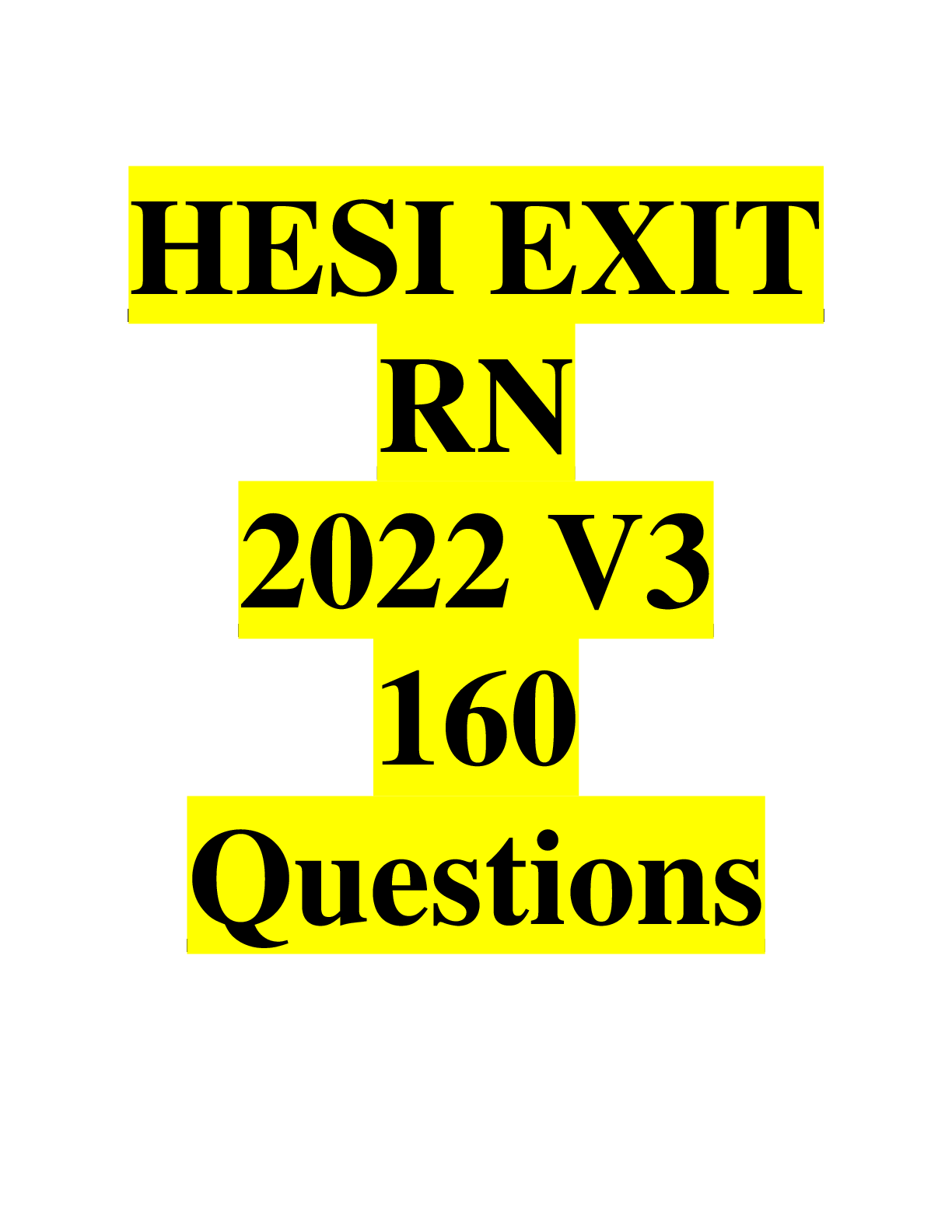
Instant download
Reviews( 0 )
Document information
Connected school, study & course
About the document
Uploaded On
Feb 08, 2023
Number of pages
37
Written in
Additional information
This document has been written for:
Uploaded
Feb 08, 2023
Downloads
0
Views
199

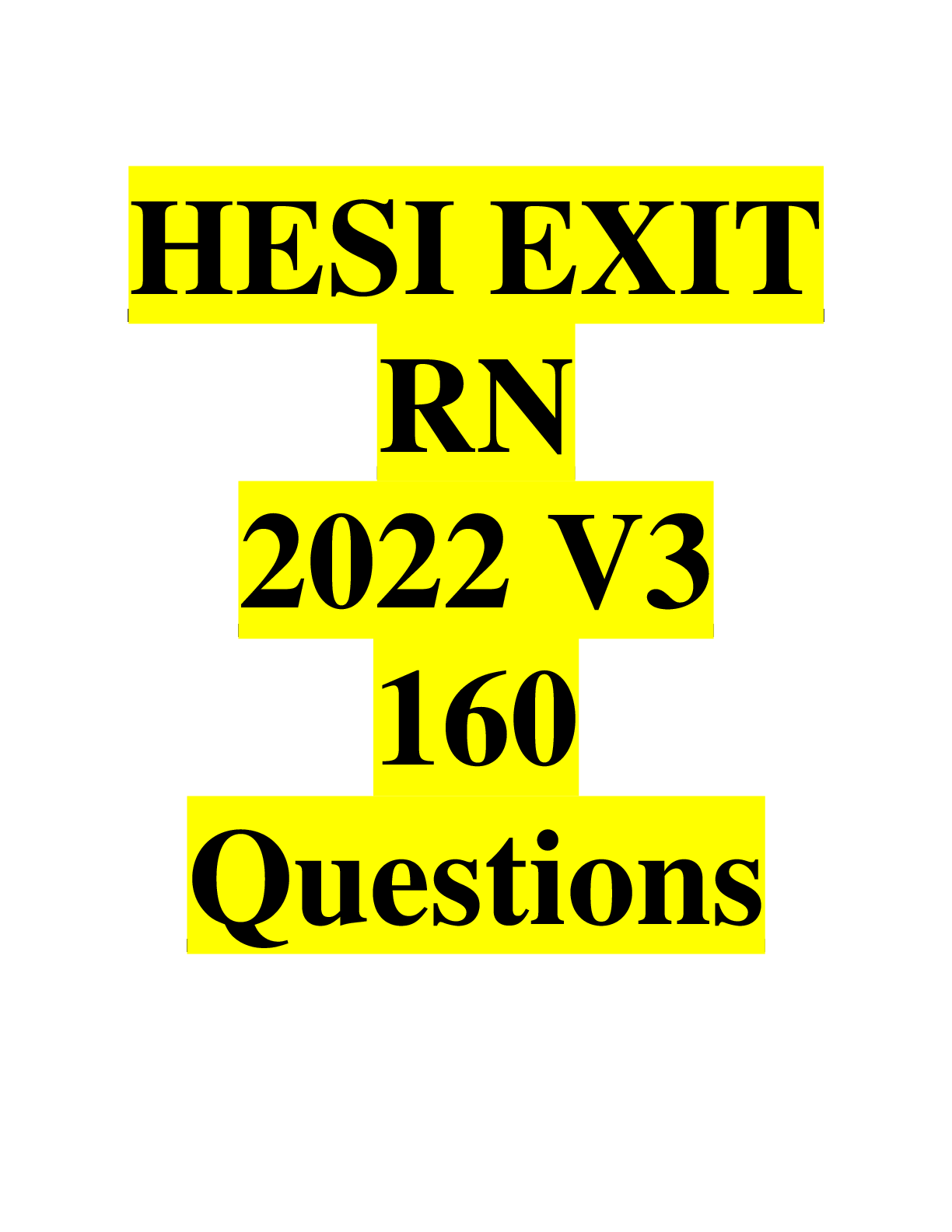
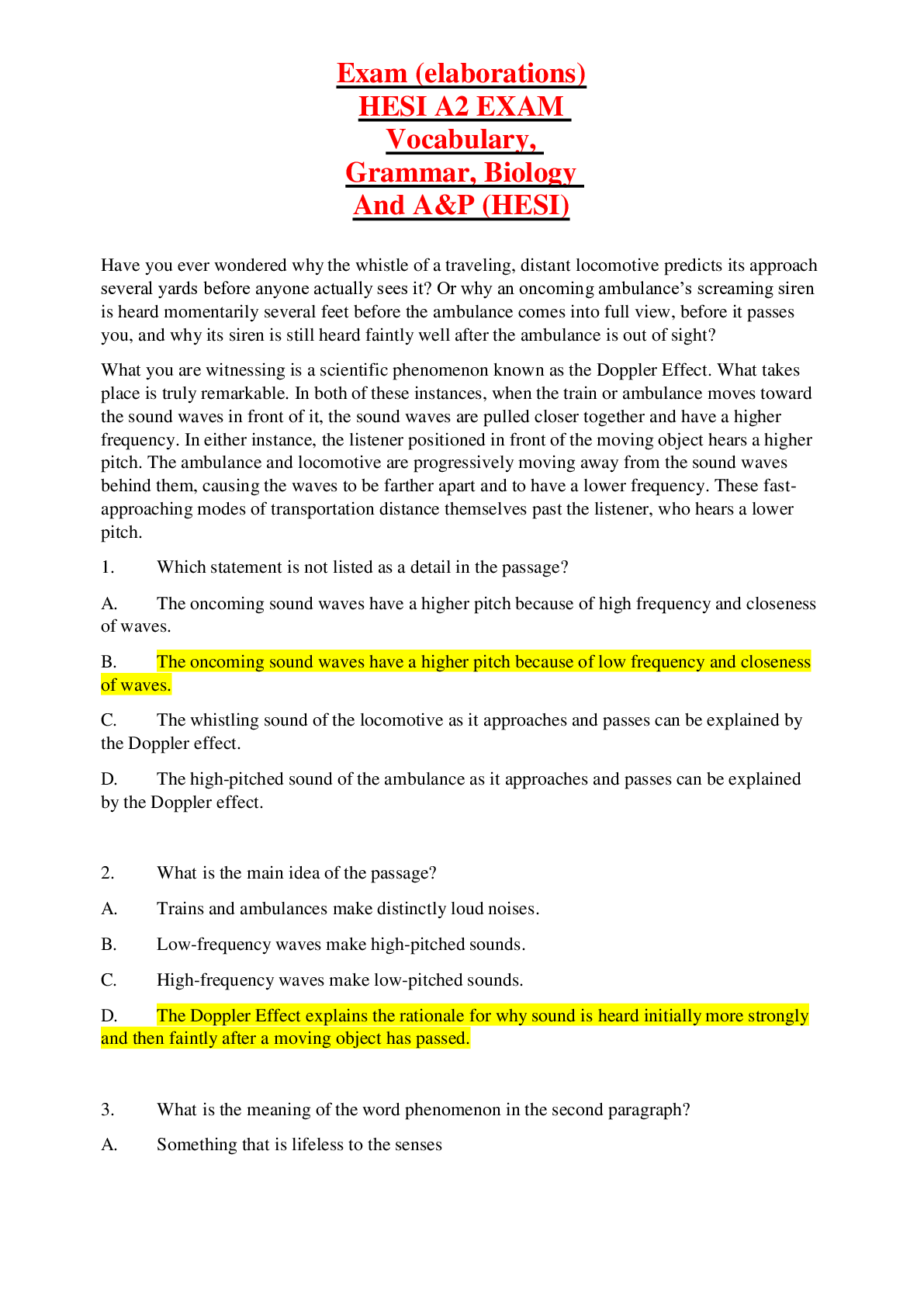


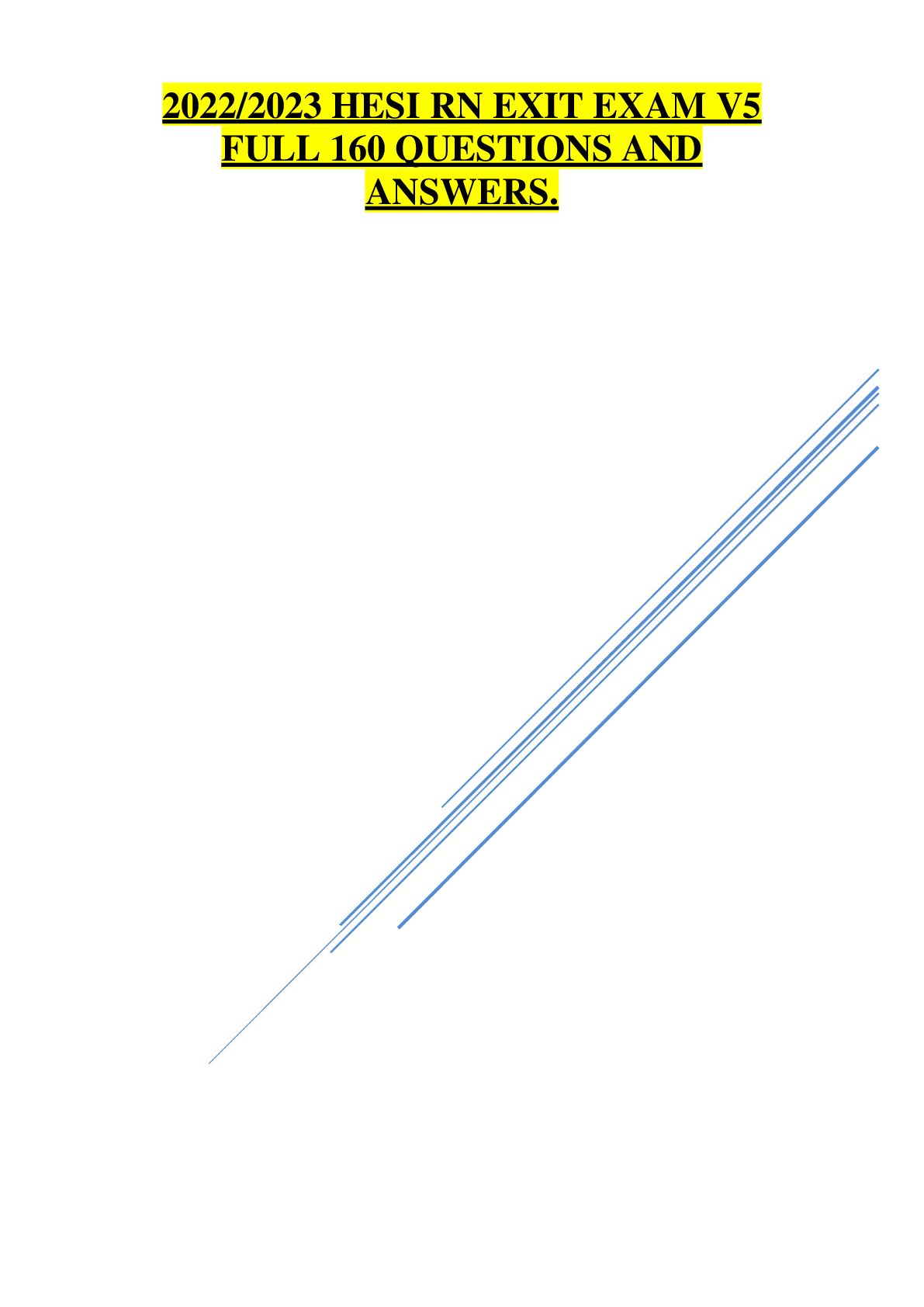
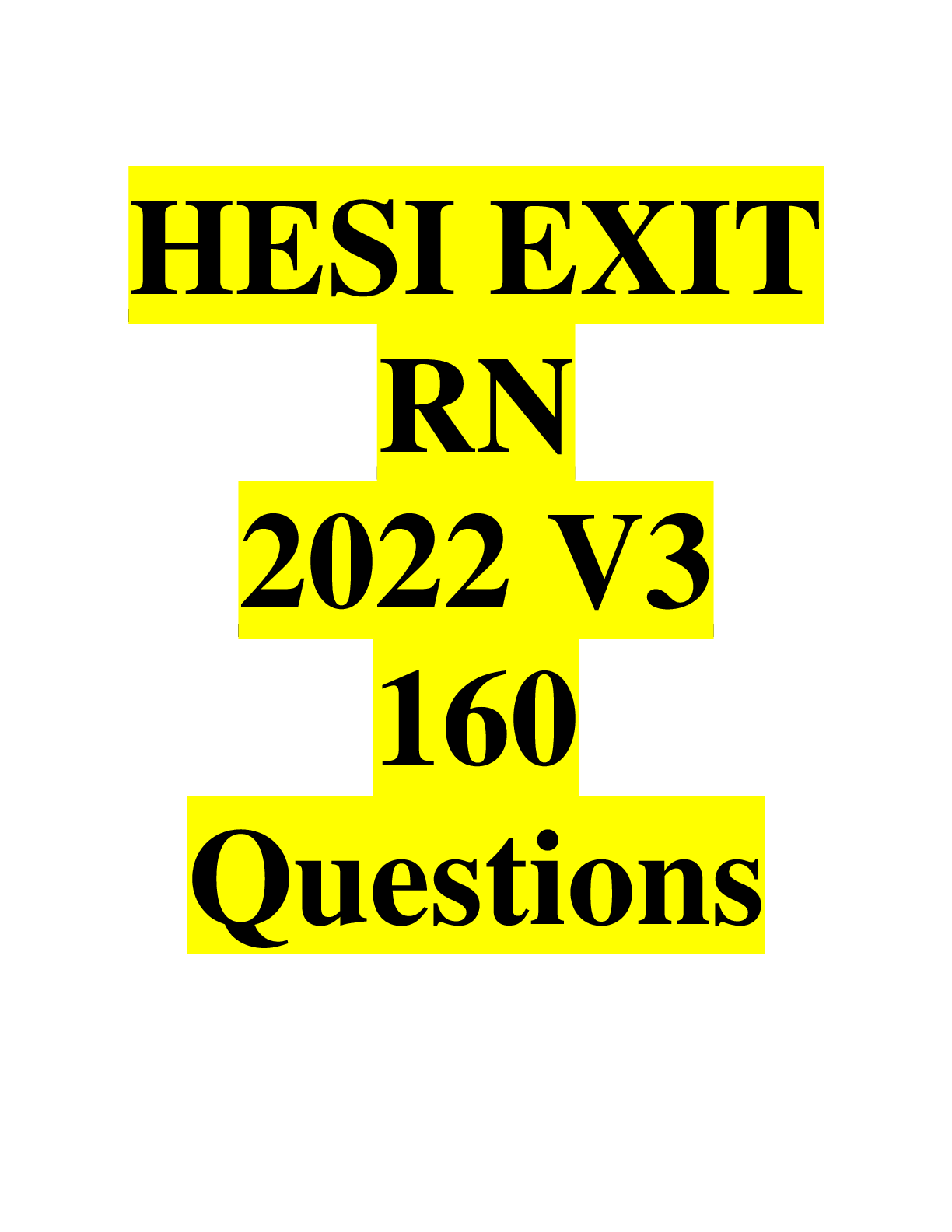
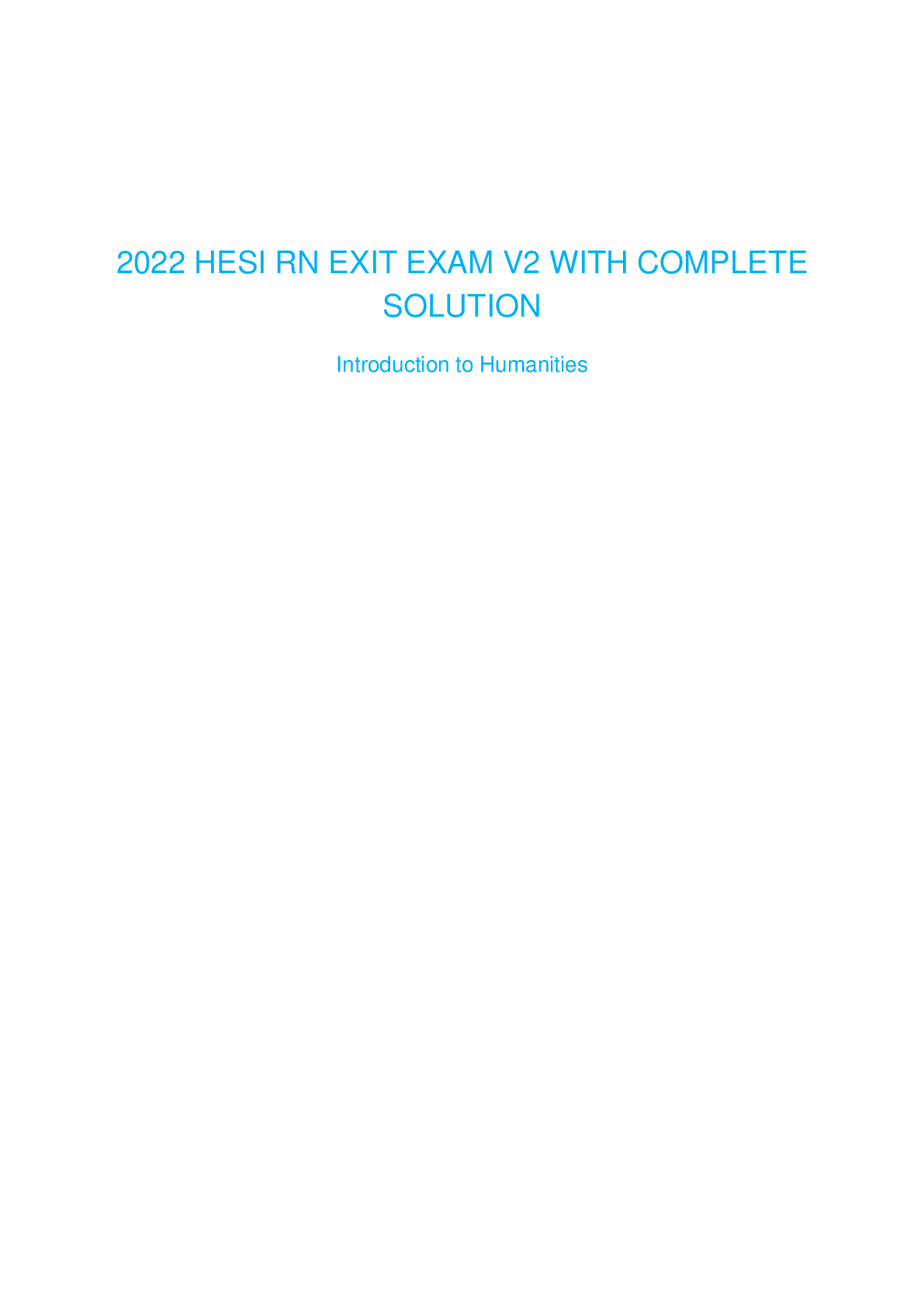

 GRADED A+.png)

